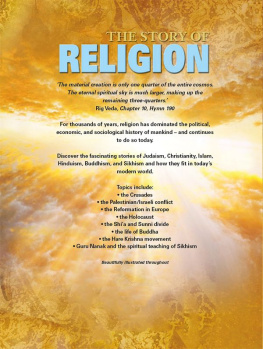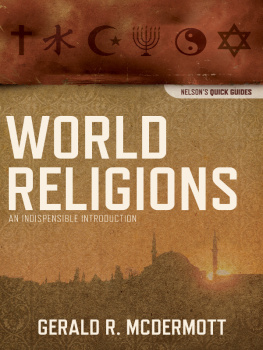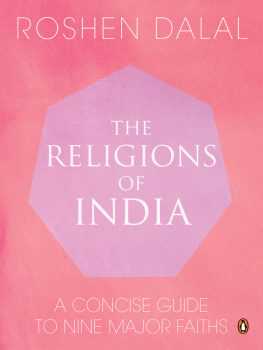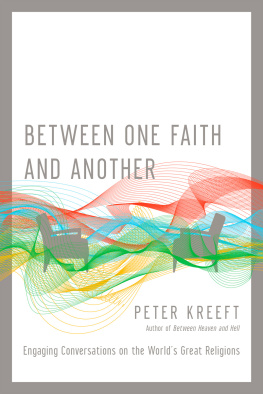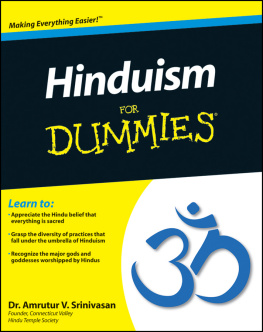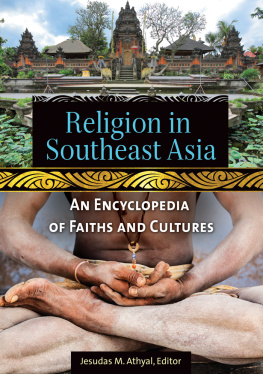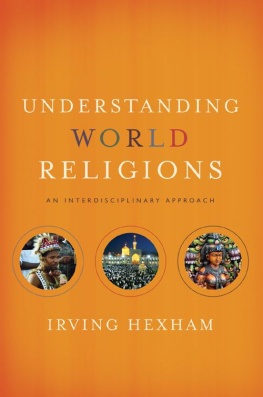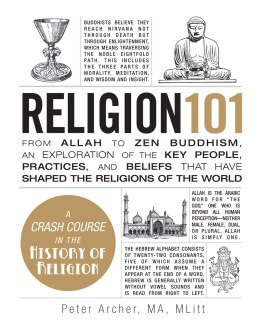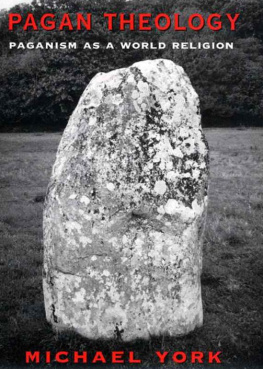
CHAPTER 1
JUDAISM
J UDAISM is not just a religion. The Jewish people are an ethnic group: everyone who has a Jewish mother is considered Jewish, whether they practise the religion or not. Consequently, the history of the Jewish religion is also the history of the Jewish people. Jews believe they are descended from a tribe of people that lived in the ancient land of Canaan, which encompasses most of modern Israel, Palestine, Jordan and Syria. The story of the origins of the Jews, who were also known as Israelites or Hebrews in ancient times, is found in the Torah, a sacred text containing the first five books of the Bible. According to the first book, Genesis, the original ancestor of the Jewish people was a man called Abraham.

Abraham and the Israelites In around 1800 BCE, Abraham and his clan left Ur in Mesopotamia (modern-day Iraq) and travelled to Canaan. Abraham had a son, Isaac, who in turn fathered Jacob. Jacobs twelve sons founded the twelve tribes of Israel. Owing to a severe famine in Canaan, some of the tribes settled in Egypt, where they were enslaved. Several generations later, according to the Book of Exodus, a great leader called Moses led the Israelites out of slavery and to freedom in Canaan.
There is some archaeological evidence for the biblical account of Abrahams migration. Between 2000 and 1500 BCE, a nomadic group called the Amorites invaded Mesopotamia, which led to the decline of Ur. This may have prompted Abrahams departure from the region. Scholars disagree about the flight from Egypt to Canaan, however. While some believe that the Israelites left Egypt in one mass migration, as stated in the Bible, others argue that a more gradual settlement of Canaan was more likely.
The mitzvoth and the Halacha The Israelites gradually formed one nation with a set of strong religious principles. They were united by their belief in an all-powerful God who created the universe. They believed that Moses received the Torah directly from God and that the Israelites had a covenant with God: God would look after them if they followed the mitzvoth (commandments) in the Torah.
The mitzvoth lay down the rules of behaviour for all areas of Jewish religious and daily life. For example, Jews must eat kosher food food that has been prepared so that it is suitable under Jewish law. Jews must also keep Shabbat, or the Sabbath, as a day of prayer and rest. God also gave Moses the Halacha, the oral Torah, which explained how the commandments were to be kept. The Halacha was handed down the generations by word of mouth.

This map shows the emergence of the Jewish people between around 2000 and 1000 BCE. According to the Bible, Abraham, Isaac and Jacob lived in Beersheba, in modern-day southern Israel.
The kingdom of Israel The Torah describes how the twelve Israelite tribes in Canaan were ruled by councils of elders in peacetime. During wartime, each tribe was led by a judge, who was a tribal chieftain. Many wars were fought. The most powerful enemies of the Israelites were the Philistines, who had established themselves in the southern coastal plain of Canaan by the end of the 11th century BCE. They frequently attacked the Israelite tribes. As separate tribes, the Israelites proved too weak to repel the Philistine threat. They eventually united into one kingdom, the kingdom of Israel.
HEBRON, HOLY CITY
According to Genesis, Abrahams wife Sarah died in Hebron.
Abraham purchased a cave and the surrounding field as a burial place for her. The tomb is also believed to be the burial place of Abraham, Isaac, Jacob and their wives (except for Jacobs wife Rachel, who was buried near Bethlehem). The site, near the modern city of Hebron in the West Bank, is holy to Jews, Christians and Muslims, who all see Abraham as their ancestor.
So Ephrons field in Machpelah near Mamre both the field and the cave in it, and all the trees within the borders of the field was legally made over to Abraham as his property in the presence of all the Hittites [a local clan] who had come to the gate of the city. Afterwards Abraham buried his wife Sarah in the cave in the field of Machpelah near Mamre (which is at Hebron) in the land of Canaan.
Genesis 23:1719
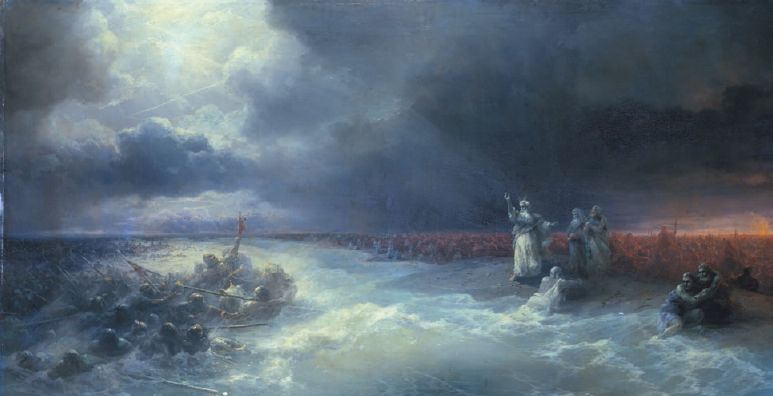
According to the Book of Exodus, Moses parted the waves of the sea so that the Israelites could escape from Egypt.
The Israelites under the kings The kingdom of Israel lasted from around 1000 BCE to 586 BCE. The first king was Saul, who defeated many enemies and checked the advance of the Philistines. Saul was succeeded by David, who crushed the Philistines and conquered the city of Jerusalem, which he made his capital. Jerusalem became the spiritual focus of the Jewish religion. Davids successor, Solomon, created a powerful kingdom and brought peace and prosperity. He built fortified towns and the magnificent First Temple in Jerusalem.
Despite having a reputation for wisdom, Solomon sowed the seeds of division in the kingdom, for example, by taxing all the tribes except his own tribe of Judah. After his death in 928 BCE, the northern tribes rebelled and set up their own kingdom, named Israel, while the southern tribes stayed loyal to Solomons son and established the kingdom of Judah.
This description of Solomons kingdom at its height is from the Bible:
Judah and Israel were many, as the sand which is by the sea, in multitude, eating and drinking, and making merry. And Solomon reigned over all kingdoms from the river [Euphrates] unto the land of the Philistines, and unto the border of Egypt: they brought presents, and served Solomon all the days of his life. For he had dominion over all the region on this side of the river and he had peace on all sides around him. And Solomons wisdom excelled all the wisdom of all the children of the east country, and all the wisdom of Egypt and his fame was in all nations round about.
1 Kings 4:2031
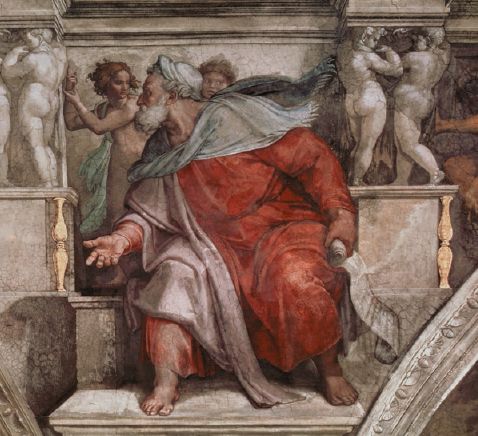
This detail from a fresco by Michelangelo in the Sistine Chapel in Rome depicts the Prophet Ezekiel. Ezekiel was one of the Israelites exiled to Babylonia after the Babylonians conquered Judah in 586 BCE. He prophesised that the Israelites would return to their homeland.
Destruction of the kingdoms In 722 BCE, the Assyrians (from Mesopotamia) captured Samaria, the capital of Israel. Israel was absorbed into the Assyrian Empire and its population was deported to Mesopotamia. The exiled people became known as the ten lost tribes of Israel. During the following century, the Assyrian Empire declined, and Babylon, a city in Mesopotamia, grew stronger. In 586 BCE, the Babylonians conquered Jerusalem, destroyed Solomons Temple and ended the kingdom of Judah. The Israelites were captured or sent into exile in Babylon, where they formed an organized community and preserved their Jewish identity.

Next page
